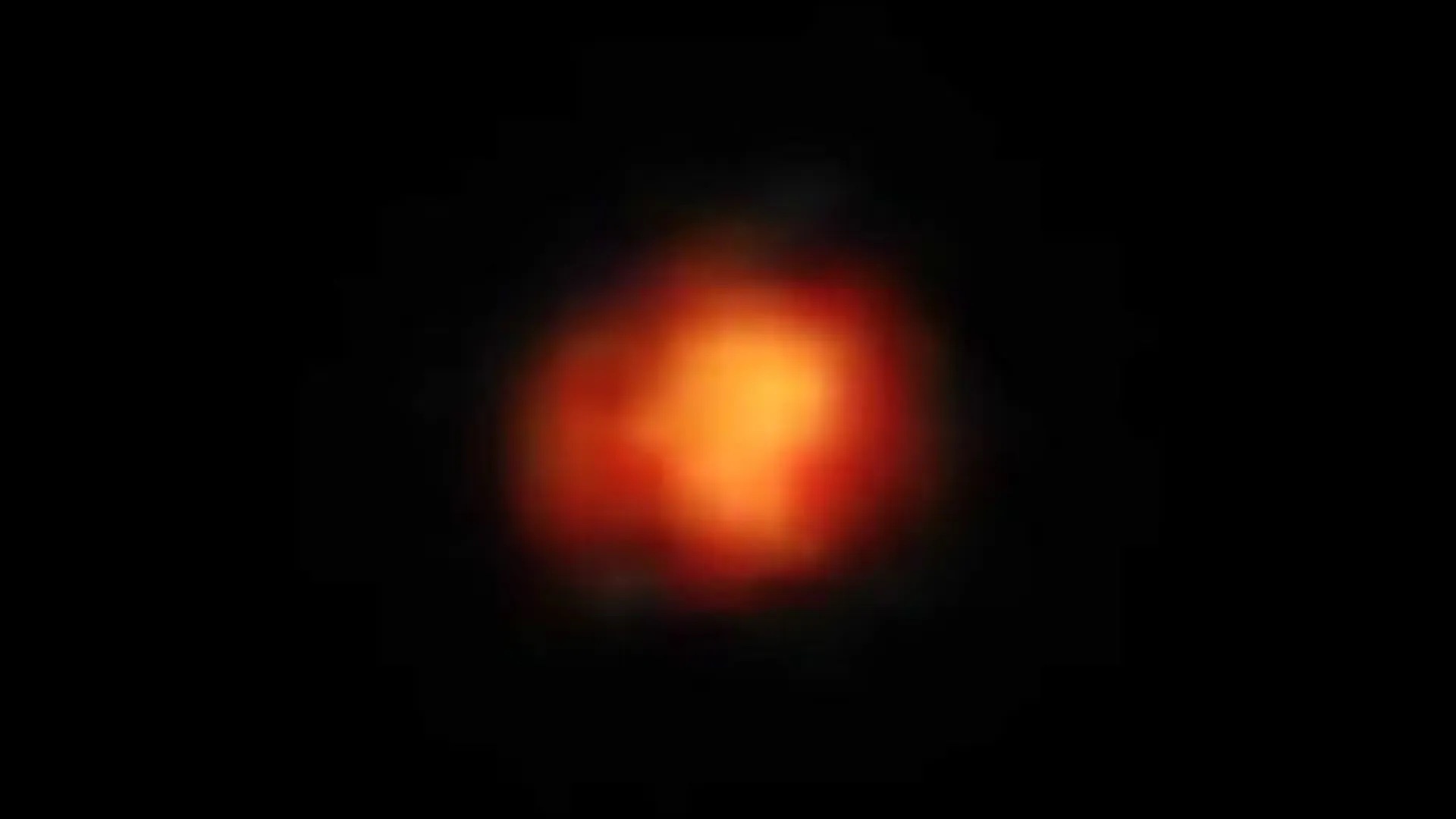26.07.2023
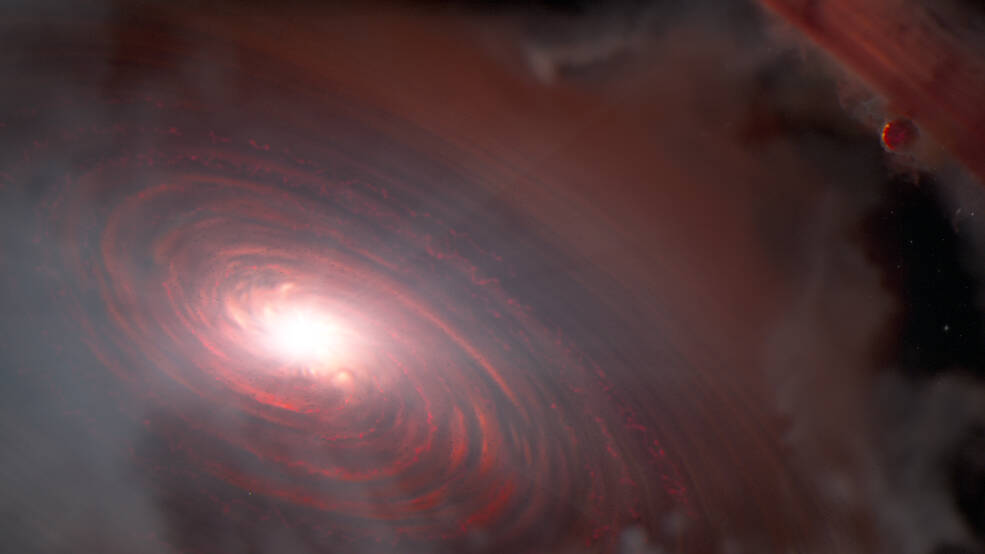
Water is essential for life as we know it. However, scientists debate how it reached the Earth and whether the same processes could seed rocky exoplanets orbiting distant stars. New insights may come from the planetary system PDS 70, located 370 light-years away. The star hosts both an inner disk and outer disk of gas and dust, separated by a 5 billion-mile-wide (8 billion kilometer) gap, and within that gap are two known gas-giant planets.
New measurements by NASA’s James Webb Space Telescope’s MIRI (Mid-Infrared Instrument) have detected water vapor in the system’s inner disk, at distances of less than 100 million miles (160 million kilometers) from the star – the region where rocky, terrestrial planets may be forming. (The Earth orbits 93 million miles from our Sun.) This is the first detection of water in the terrestrial region of a disk already known to host two or more protoplanets.
“We’ve seen water in other disks, but not so close in and in a system where planets are currently assembling. We couldn’t make this type of measurement before Webb,” said lead author Giulia Perotti of the Max Planck Institute for Astronomy (MPIA) in Heidelberg, Germany.
“This discovery is extremely exciting, as it probes the region where rocky planets similar to Earth typically form,” added MPIA director Thomas Henning, a co-author on the paper. Henning is co-principal investigator of Webb’s MIRI (Mid-Infrared Instrument), which made the detection, and the principal investigator of the MINDS (MIRI Mid-Infrared Disk Survey) program that took the data.
A Steamy Environment for Forming Planets
PDS 70 is a K-type star, cooler than our Sun, and is estimated to be 5.4 million years old. This is relatively old in terms of stars with planet-forming disks, which made the discovery of water vapor surprising.
Over time, the gas and dust content of planet-forming disks declines. Either the central star’s radiation and winds blow out such material, or the dust grows into larger objects that eventually form planets. As previous studies failed to detect water in the central regions of similarly aged disks, astronomers suspected it might not survive the harsh stellar radiation, leading to a dry environment for the formation of any rocky planets.
Astronomers haven’t yet detected any planets forming within the inner disk of PDS 70. However, they do see the raw materials for building rocky worlds in the form of silicates. The detection of water vapor implies that if rocky planets are forming there, they will have water available to them from the beginning.
“We find a relatively high amount of small dust grains. Combined with our detection of water vapor, the inner disk is a very exciting place,” said co-author Rens Waters of Radboud University in The Netherlands.
What is the Water’s Origin?
The discovery raises the question of where the water came from. The MINDS team considered two different scenarios to explain their finding.
One possibility is that water molecules are forming in place, where we detect them, as hydrogen and oxygen atoms combine. A second possibility is that ice-coated dust particles are being transported from the cool outer disk to the hot inner disk, where the water ice sublimates and turns into vapor. Such a transport system would be surprising, since the dust would have to cross the large gap carved out by the two giant planets.
Another question raised by the discovery is how water could survive so close to the star, when the star’s ultraviolet light should break apart any water molecules. Most likely, surrounding material such as dust and other water molecules serves as a protective shield. As a result, the water detected in the inner disk of PDS 70 could survive destruction.
Ultimately, the team will use two more of Webb’s instruments, NIRCam (Near-Infrared Camera) and NIRSpec (Near-Infrared Spectrograph) to study the PDS 70 system in an effort to glean an even greater understanding.
These observations were taken as part of Guaranteed Time Observation program 1282. This finding has been published in the journal Nature.
Quelle: NASA
----
Update: 27.07.2023
.
JWST spots ionized molecule that could be involved in the emergence of life
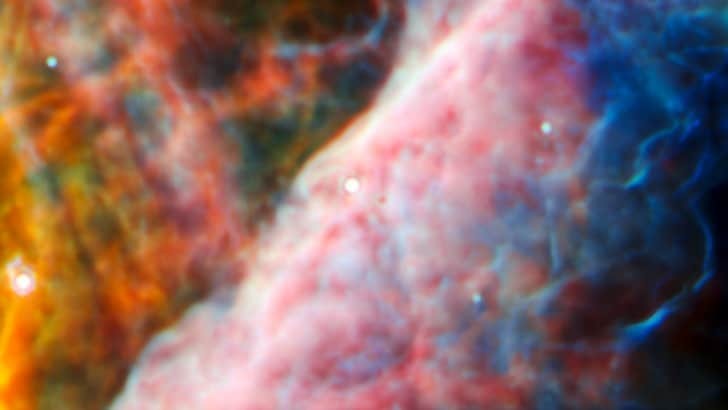
Star-forming region: image from the JWST’s Mid-Infrared Instrument shows a small region of the Orion Nebula. At the centre of this image is d203-506, where astronomers have observed methyl cations for the first time in d203-506. (Courtesy: ESA/Webb, NASA, CSA, M. Zamani (ESA/Webb), and the PDRs4All ERS Team)
For the first time, astronomers have observed the signature of methyl cations in a planet-forming disc. Using the James Webb Space Telescope (JWST), a team led by Olivier Berné at the University of Toulouse has shown that methyl cations – an important precursor to complex organic chemistry – are formed in the intense ultraviolet radiation emitted by massive young stars nearby.
In the 1970s astronomers first proposed that the methyl cation molecule (CH3+) could be a key trigger for complex organic chemistry in space – a process that could eventually lead to the emergence of life. Evidence of CH3+ in space could point to the presence of larger molecules – but so far, a combination of factors have meant that CH3+ had not been observed outside the solar system.
The main challenge facing those trying to observe the ion is that CH3+ does not have a permanent dipole moment which makes it invisible to radio telescopes. Alternatively, the ion can be identified from the spectroscopic lines it imprints on infrared radiation. However, these wavelengths are heavily absorbed or scattered by Earth’s atmosphere, making them practically impossible to view from the ground.
Young red dwarf
From its orbit high above Earth, the JWST has now detected this spectroscopic signature in a system called d203-506, which is 1350 light-years away in the Orion nebula. The system comprises a young red dwarf star that is surrounded by a planet-forming disc.
Because CH3+ had been so elusive, Berné’s team struggled to identify the signature, but the team eventually identified it as the first ever detection of interstellar CH3+. “Our discovery was only made possible because astronomers, modellers and laboratory spectroscopists joined forces to understand the unique features observed by James Webb,” explains team member Marie-Aline Martin-Drumel at Paris-Saclay University.
The result is especially fascinating because the Orion nebula is crowded with young, massive stars, which bathe d203-506 in intense ultraviolet radiation. Based on chemical signatures found in meteorites, astronomers now widely believe that planetary systems like the solar system were once bombarded with similar levels of radiation. This radiation may have originated from massive stars, such as those that formed from the same cloud of material that created the Sun. These huge stars then burned out after just a few million years.
Destructive radiation
Although intense ultraviolet radiation is destructive to complex organic molecules, these latest results suggest it could provide the energy needed to ionize methane, triggering the production of CH3+. Another interesting finding was the lack of water detected in d203-506 – which could also be related to high levels of ultraviolet radiation.
“This clearly shows that ultraviolet radiation can completely change the chemistry of a proto-planetary disc,” Berné explains. “It might actually play a critical role in the early chemical stages of the origins of life by helping to produce CH3+ – something that has perhaps previously been underestimated.”
This process could enable more complex molecules to emerge later on, once the massive stars have burned out. At this point the ions could eventually go on to form amino acids, nucleotides, and other key molecular building blocks of life.
Altogether, the result is a key milestone in our understanding of the chemistry of emerging star systems. “This detection of CH3+ not only validates the incredible sensitivity of [the JWST] but also confirms the postulated central importance of CH3+ in interstellar chemistry,” Martin-Drumel says. As JWST continues its exploration of the sky, the team hopes their result will be just the start of a new wave of similar discoveries.
Quelle: physicsworld
----
Update: 28.07.2023
.
Webb Snaps Highly Detailed Infrared Image of Actively Forming Stars
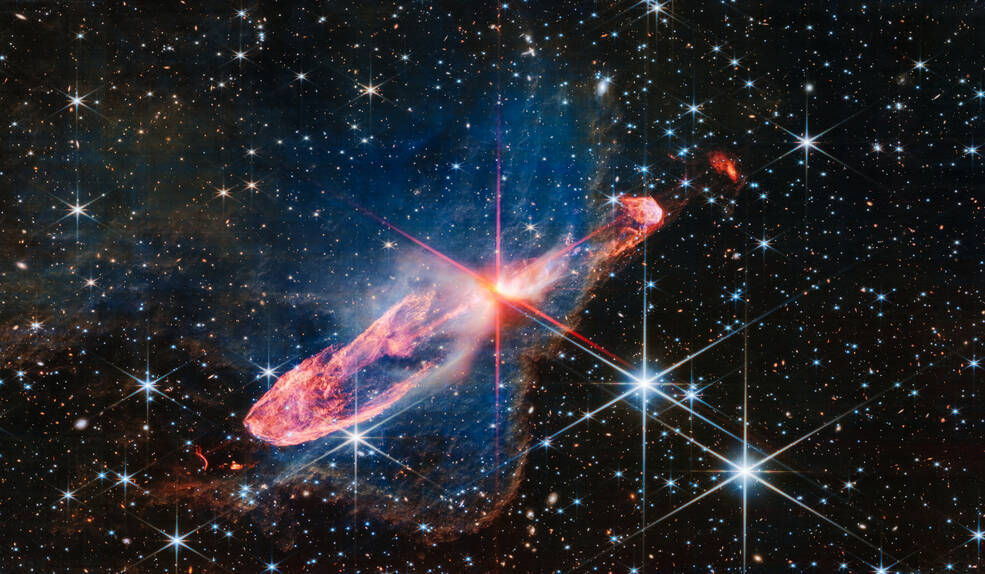
Young stars are rambunctious!
NASA’s James Webb Space Telescope has captured the “antics” of a pair of actively forming young stars, known as Herbig-Haro 46/47, in high-resolution near-infrared light. To find them, trace the bright pink and red diffraction spikes until you hit the center: The stars are within the orange-white splotch. They are buried deeply in a disk of gas and dust that feeds their growth as they continue to gain mass. The disk is not visible, but its shadow can be seen in the two dark, conical regions surrounding the central stars.
The most striking details are the two-sided lobes that fan out from the actively forming central stars, represented in fiery orange. Much of this material was shot out from those stars as they repeatedly ingest and eject the gas and dust that immediately surround them over thousands of years.
When material from more recent ejections runs into older material, it changes the shape of these lobes. This activity is like a large fountain being turned on and off in rapid, but random succession, leading to billowing patterns in the pool below it. Some jets send out more material and others launch at faster speeds. Why? It’s likely related to how much material fell onto the stars at a particular point in time.
The stars’ more recent ejections appear in a thread-like blue. They run just below the red horizontal diffraction spike at 2 o’clock. Along the right side, these ejections make clearer wavy patterns. They are disconnected at points, and end in a remarkable uneven light purple circle in the thickest orange area. Lighter blue, curly lines also emerge on the left, near the central stars, but are sometimes overshadowed by the bright red diffraction spike.
All of these jets are crucial to star formation itself. Ejections regulate how much mass the stars ultimately gather. (The disk of gas and dust feeding the stars is small. Imagine a band tightly tied around the stars.)
Now, turn your eye to the second most prominent feature: the effervescent blue cloud. This is a region of dense dust and gas, known both as a nebula and more formally as a Bok globule. When viewed mainly in visible light, it appears almost completely black – only a few background stars peek through. In Webb’s crisp near-infrared image, we can see into and through the gauzy layers of this cloud, bringing a lot more of Herbig-Haro 46/47 into focus, while also revealing a deep range of stars and galaxies that lie well beyond it. The nebula’s edges appear in a soft orange outline, like a backward L along the right and bottom.
This nebula is significant – its presence influences the shapes of the jets shot out by the central stars. As ejected material rams into the nebula on the lower left, there is more opportunity for the jets to interact with molecules within the nebula, causing them both to light up.
There are two other areas to look at to compare the asymmetry of the two lobes. Glance toward the upper right to pick out a blobby, almost sponge-shaped ejecta that appears separate from the larger lobe. Only a few threads of semi-transparent wisps of material point toward the larger lobe. Almost transparent, tentacle-like shapes also appear to be drifting behind it, like streamers in a cosmic wind. In contrast, at lower left, look beyond the hefty lobe to find an arc. Both are made up of material that was pushed the farthest and possibly by earlier ejections. The arcs appear to be pointed in different directions, and may have originated from different outflows.
Take another long look at this image. Although it appears Webb has snapped Herbig-Haro 46/47 edge-on, one side is angled slightly closer to Earth. Counterintuitively, it’s the smaller right half. Though the left side is larger and brighter, it is pointing away from us.
Over millions of years, the stars in Herbig-Haro 46/47 will fully form – clearing the scene of these fantastic, multihued ejections, allowing the binary stars to take center stage against a galaxy-filled background.
Webb can reveal so much detail in Herbig-Haro 46/47 for two reasons. The object is relatively close to Earth, and Webb’s image is made up of several exposures, which adds to its depth.
Herbig-Haro 46/47 lies only 1,470 light-years away in the Vela Constellation.
The James Webb Space Telescope is the world's premier space science observatory. Webb is solving mysteries in our solar system, looking beyond to distant worlds around other stars, and probing the mysterious structures and origins of our universe and our place in it. Webb is an international program led by NASA with its partners, ESA (European Space Agency) and the Canadian Space Agency.James Webb Space Telescope sees Jupiter moons in a new light
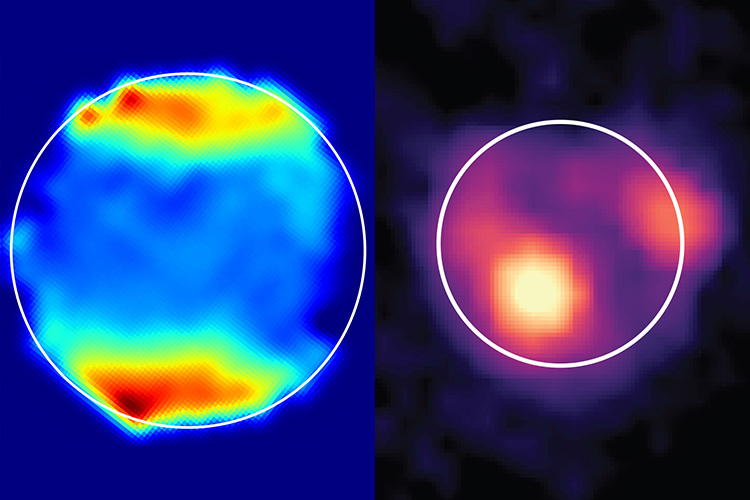
A spectroscopic map of Ganymede (left) derived from JWST measurements shows light absorption around the poles characteristic of the molecule hydrogen peroxide. A JWST infrared image of Io (right) shows hot volcanic eruptions at Kanehekili Fluctus (center) and Loki Patera (right). The circles outline the surfaces of the two moons. (Image credit: Ganymede: Samantha Trumbo, Cornell; Io: Imke de Pater, UC Berkeley)
With its sensitive infrared cameras and high-resolution spectrometer, the James Webb Space Telescope (JWST) is revealing new secrets of Jupiter’s Galilean satellites, in particular Ganymede, the largest moon, and Io, the most volcanically active.
In two separate publications, astronomers who are part of JWST’s Early Release Science program report the first detection of hydrogen peroxide on Ganymede and sulfurous fumes on Io, both the result of Jupiter’s domineering influence.
“This shows that we can do incredible science with the James Webb Space Telescope on solar system objects, even if the object is really very bright, like Jupiter, but also when you look at very faint things next to Jupiter,” said Imke de Pater, professor emerita of astronomy and earth and planetary science at the University of California, Berkeley. De Pater and Thierry Fouchet from the Paris Observatory are co-principal investigators for the Early Release Science solar system observation team, one of 13 teamsgiven early access to the telescope.
Samantha Trumbo, a 51 Pegasi b postdoctoral fellow at Cornell University, led the study of Ganymede, which was published July 21 in the journal Science Advances. Using measurements captured by the near infrared spectrometer (NIRSpec) on JWST, the team detected the absorption of light by hydrogen peroxide — H2O2 — around the north and south poles of the moon, a result of charged particles around Jupiter and Ganymede impacting the ice that blankets the moon.
“JWST revealing the presence of hydrogen peroxide at Ganymede’s poles shows for the first time that charged particles funneled along Ganymede’s magnetic field are preferentially altering the surface chemistry of its polar caps,” Trumbo said.

Closeup photos of Ganymede and Io taken by NASA’s Juno spacecraft in 1997 as it was orbiting Jupiter. (Photo credit: NASA/JPL/USGS)
The astronomers argue that the peroxide is produced by charged particles hitting the frozen water ice around the poles and breaking the water molecules into fragments — a process called radiolysis — which then recombine to form H2O2. They suspected that radiolysis would occur primarily around the poles on Ganymede because, unlike all other moons in our solar system, it has a magnetic field that directs charged particles toward the poles.
“Just like how Earth’s magnetic field directs charged particles from the sun to the highest latitudes, causing the aurora, Ganymede’s magnetic field does the same thing to charged particles from Jupiter’s magnetosphere,” she added. “Not only do these particles result in aurorae at Ganymede, as well, but they also impact the icy surface.”
Trumbo and Michael Brown, professor of planetary astronomy at Caltech, where Trumbo recently received her Ph.D., had earlier studied hydrogen peroxide on Europa, another of Jupiter’s four Galilean satellites. On Europa, however, the peroxide was detectable over much of the surface, perhaps, in part, because it has no magnetic field to protect the surface from the fast-moving particles zipping around Jupiter.
“This is likely a really important and widespread process,” Trumbo said. “These observations of Ganymede provide a key window to understand how such water radiolysis might drive chemistry on icy bodies throughout the outer solar system, including on neighboring Europa and Callisto (the fourth Galilean moon).”
“It helps to actually understand how this so-called radiolysis works and that, indeed, it works as people expected, based on lab experiments on Earth,” de Pater said.
Io’s sulfurous environment
In a second paper, accepted for publication in the journal JGR: Planets, a publication of the American Geophysical Union, de Pater and her colleagues report new Webb observations of Io that show several ongoing eruptions, including a brightening at a volcanic complex called Loki Patera and an exceptionally bright eruption at Kanehekili Fluctus. Because Io is the only volcanically active moon in the solar system — Jupiter’s gravitational push and pull heats it up — studies like this give planetary scientists a different perspective than can be obtained by studying volcanos on Earth.

JWST measurements obtained in November 2022 overlaid on a map of Io’s surface. Thermal infrared measurements (right) show a brightening of Kanekehili Fluctus, a large and, during the observation period, very active volcanic area on Io. Spectral measurements (left) show forbidden infrared emissions from sulfur monoxide centered on the volcanic area. The coincidence confirms a theory that SO is produced in volcanic vents and, in the very thin atmosphere of Io, remain around long enough to emit the forbidden line that would normally be suppressed by collisions with other molecules in the atmosphere. (Image credit: Chris Moeckel and Imke de Pater, UC Berkeley; Io map courtesy of USGS)
For the first time, the researchers were able to link a volcanic eruption — at Kanehekili Fluctus — to a specific emission feature produced by so-called “forbidden” transitions of the gas sulfur monoxide (SO).
Sulfur dioxide (SO2) is the main component of Io’s atmosphere, coming from sublimation of SO2 ice, as well as ongoing volcanic eruptions, similar to the production of SO2 by volcanos on Earth. The volcanos also produce SO, which is much harder to detect than SO2. In particular, the forbidden SO emission line is very weak because SO is in such low concentrations and produced for only a short time after being excited. Moreover, the observations can only be made when Io is in Jupiter’s shadow, when it is easier to see the glowing SO gases. When Io is in Jupiter’s shadow, the SO2 gas in Io’s atmosphere freezes out onto its surface, leaving only SO and newly emitted volcanic SO2 gas in the atmosphere.
“These observations with Webb show for the first time that this excited SO actually did come from a volcano,” de Pater said.
De Pater had made previous observations of Io with the Keck Telescope in Hawaii and found low levels of the forbidden SO emission over much of the moon, but she was unable to tie SO hotspots specifically to an active volcano. She suspects that much of this SO, as well as the SO2 seen during an eclipse, is coming from so-called stealth volcanoes, which erupt gas but not dust, which would make them visible.
Twenty years ago, de Pater and her team proposed that this excited state of SO could only be produced in hot volcanic vents, and that the tenuous atmosphere allowed this state to stick around long enough — a few seconds — to emit the forbidden line. Normally, excited states that produce this emission are quickly damped out by collisions with other molecules in the atmosphere and never seen. Only in parts of the atmosphere where the gas is sparse do such excited states last long enough to emit forbidden lines. The greens and reds of Earth’s auroras are produced by forbidden transitions of oxygen in the tenuous upper atmosphere.
“The link between SO and volcanoes ties in with a hypothesis we had in 2002 to explain how we could see SO emission at all,” she said. “The only way we could explain this emission is if the SO is excited in the volcanic vent at a temperature of 1500 Kelvin or so, and that it comes out in this excited state, loses its photon within a few seconds, and that is the emission we see. So these observations are the first that actually show that this is the most likely mechanism of why we see that SO.”
Webb will observe Io again in August with NIRSpec. The upcoming observation and the earlier one, which took place on Nov. 15, 2022, were taken when Io was in the shadow of Jupiter so that light reflected from the planet did not overwhelm the light coming from Io.
De Pater noted, too, that the brightening of Loki Patera was consistent with the observed period of eruptions at the volcano, which brighten, on average, about every 500 Earth days, with the brightening lasting for a couple of months. She determined this because it was not bright when she observed the moon with Keck in August and September 2022, nor was it bright when another astronomer observed it from April through July 2022. Only the JWST captured the event.
“The Webb observations showed that actually eruptions had started, and that it was much brighter than what we had seen in September,” she said.
While De Pater is primarily focused on the Jovian system — its rings, small moons and the larger moons Ganymede and Io — she and other members of the early science team of some 80 astronomers are also using JWST to study the planetary systems of Saturn, Uranus and Neptune.
Quelle: University of California Berkeley
----
Update: 4.08.2023
.
Webb Spotlights Gravitational Arcs in ‘El Gordo’ Galaxy Cluster
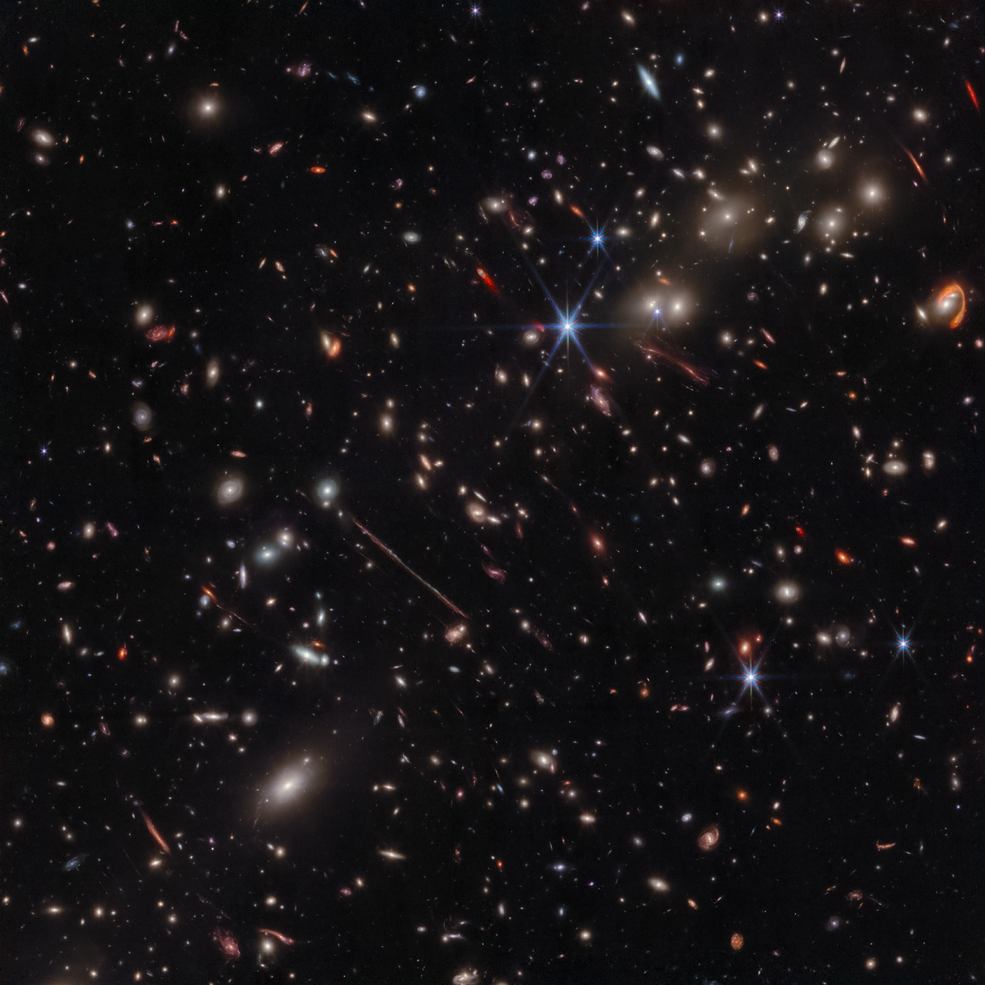
Webb’s infrared image of the galaxy cluster El Gordo (“the Fat One”) reveals hundreds of galaxies, some never before seen at this level of detail. El Gordo acts as a gravitational lens, distorting and magnifying the light from distant background galaxies. Image: NASA, ESA, CSA. Science: Jose Diego (Instituto de Física de Cantabria), Brenda Frye (University of Arizona), Patrick Kamieneski (Arizona State University), Tim Carleton (Arizona State University), and Rogier Windhorst (Arizona State University). Image processing: Alyssa Pagan (STScI), Jake Summers (Arizona State University), Jordan D’Silva (University of Western Australia), Anton Koekemoer (STScI), Aaron Robotham (University of Western Australia), and Rogier Windhorst (Arizona State University).
A new image of the galaxy cluster known as “El Gordo” is revealing distant and dusty objects never seen before, and providing a bounty of fresh science. The infrared image, taken by NASA’s James Webb Space Telescope, displays a variety of unusual, distorted background galaxies that were only hinted at in previous Hubble Space Telescope images.
El Gordo is a cluster of hundreds of galaxies that existed when the universe was 6.2 billion years old, making it a “cosmic teenager.” It’s the most massive cluster known to exist at that time. (“El Gordo” is Spanish for the “Fat One.”)
The team targeted El Gordo because it acts as a natural, cosmic magnifying glass through a phenomenon known as gravitational lensing. Its powerful gravity bends and distorts the light of objects lying behind it, much like an eyeglass lens.
“Lensing by El Gordo boosts the brightness and magnifies the sizes of distant galaxies. This lensing effect provides a unique window into the distant universe,” said Brenda Frye of the University of Arizona. Frye is co-lead of the PEARLS-Clusters branch of the Prime Extragalactic Areas for Reionization and Lensing Science (PEARLS) team and lead author of one of four papers analyzing the El Gordo observations.
The Fishhook
Within the image of El Gordo, one of the most striking features is a bright arc represented in red at upper right. Nicknamed “El Anzuelo” (The Fishhook) by one of Frye’s students, the light from this galaxy took 10.6 billion years to reach Earth. Its distinctive red color is due to a combination of reddening from dust within the galaxy itself and cosmological redshift due to its extreme distance.
By correcting for the distortions created by lensing, the team was able to determine that the background galaxy is disk-shaped but only 26,000 light-years in diameter – about one-fourth the size of the Milky Way. They also were able to study the galaxy’s star formation history, finding that star formation was already rapidly declining in the galaxy’s center, a process known as quenching.
“We were able to carefully dissect the shroud of dust that envelops the galaxy center where stars are actively forming," said Patrick Kamieneski of Arizona State University, lead author on a second paper. "Now, with Webb, we can peer through this thick curtain of dust with ease, allowing us to see firsthand the assembly of galaxies from the inside out."
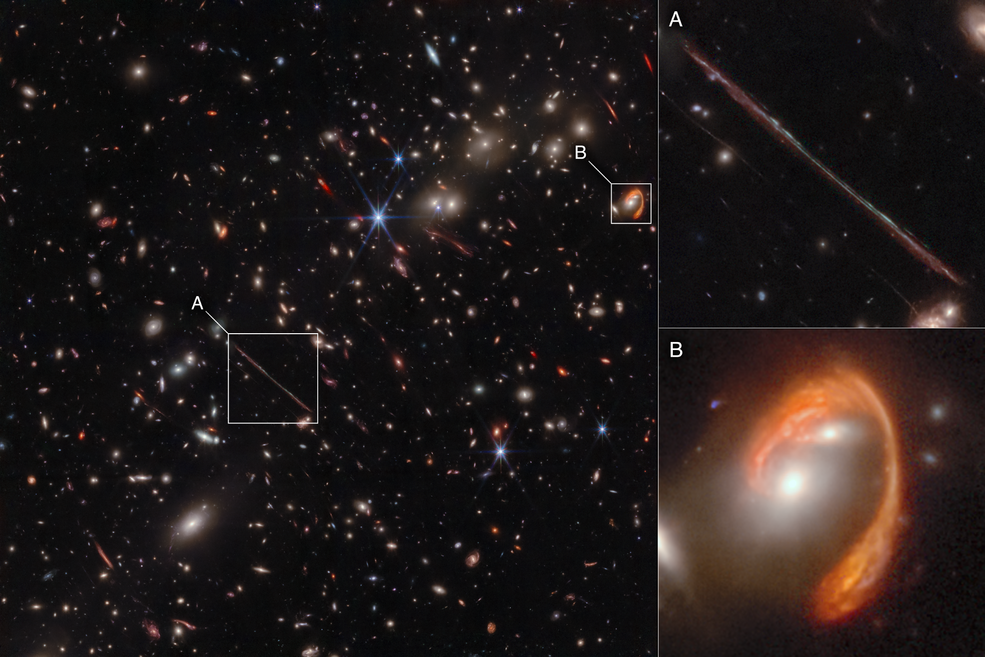
Two of the most prominent features in the image include the Thin One, highlighted in box A, and the Fishhook, a red swoosh highlighted in box B. Both are lensed background galaxies. The insets at right show zoomed-in views of both objects. Image: NASA, ESA, CSA. Science: Jose Diego (Instituto de Física de Cantabria), Brenda Frye (University of Arizona), Patrick Kamieneski (Arizona State University), Tim Carleton (Arizona State University), and Rogier Windhorst (Arizona State University). Image processing: Alyssa Pagan (STScI), Jake Summers (Arizona State University), Jordan D’Silva (University of Western Australia), Anton Koekemoer (STScI), Aaron Robotham (University of Western Australia), and Rogier Windhorst (Arizona State University).
The Thin One
Another prominent feature in the Webb image is a long, pencil-thin line at left of center. Known as “La Flaca” (the Thin One), it is another lensed background galaxy whose light also took nearly 11 billion years to reach Earth.
Not far from La Flaca is another lensed galaxy. When the researchers examined that galaxy closely, they found a single red giant star that they nicknamed Quyllur, which is the Quechua term for star.
Previously, Hubble has found other lensed stars (such as Earendel), but they were all blue supergiants. Quyllur is the first individual red giant star observed beyond 1 billion light-years from Earth. Such stars at high redshift are only detectable using the infrared filters and sensitivity of Webb.
“It's almost impossible to see lensed red giant stars unless you go into the infrared. This is the first one we’ve found with Webb, but we expect there will be many more to come,” said Jose Diego of the Instituto de Física de Cantabria in Spain, lead author of a third paper on El Gordo.
Galaxy Group and Smudges
Other objects within the Webb image, while less prominent, are equally interesting scientifically. For example, Frye and her team (which includes nine students from high school to graduate students) identified five multiply lensed galaxies which appear to be a baby galaxy cluster forming about 12.1 billion years ago. There are another dozen candidate galaxies which may also be part of this distant cluster.
“While additional data are required to confirm that there are 17 members of this cluster, we may be witnessing a new galaxy cluster forming right before our eyes, just over a billion years after the big bang,” said Frye.
A final paper examines very faint, smudge-like galaxies known as ultra-diffuse galaxies. As their name suggests, these objects, which are scattered throughout the El Gordo cluster, have their stars widely spread out across space. The team identified some of the most distant ultra-diffuse galaxies ever observed, whose light traveled 7.2 billion years to reach us.
“We examined whether the properties of these galaxies are any different than the ultra-diffuse galaxies we see in the local universe, and we do actually see some differences. In particular, they are bluer, younger, more extended, and more evenly distributed throughout the cluster. This suggests that living in the cluster environment for the past 6 billion years has had a significant effect on these galaxies,” explained Timothy Carleton of Arizona State University, lead author on the fourth paper.
“Gravitational lensing was predicted by Albert Einstein more than 100 years ago. In the El Gordo cluster, we see the power of gravitational lensing in action,” concluded Rogier Windhorst of Arizona State University, principal investigator of the PEARLS program. “The PEARLS images of El Gordo are out-of-this-world beautiful. And, they have shown us how Webb can unlock Einstein's treasure chest.”
The paper by Frye et al. has been published in the Astrophysical Journal. The paper by Kamieneski et al. has been accepted for publication in the Astrophysical Journal. The paper by Diego et al. has been published in Astronomy & Astrophysics. The paper by Carleton et al. has been accepted for publication in the Astrophysical Journal.
Quelle: NASA
----
Update: 5.08.2023
.
Stunning James Webb telescope images show death throes of distant star
High-resolution images from cutting-edge space telescope reveal inner region around central white dwarf
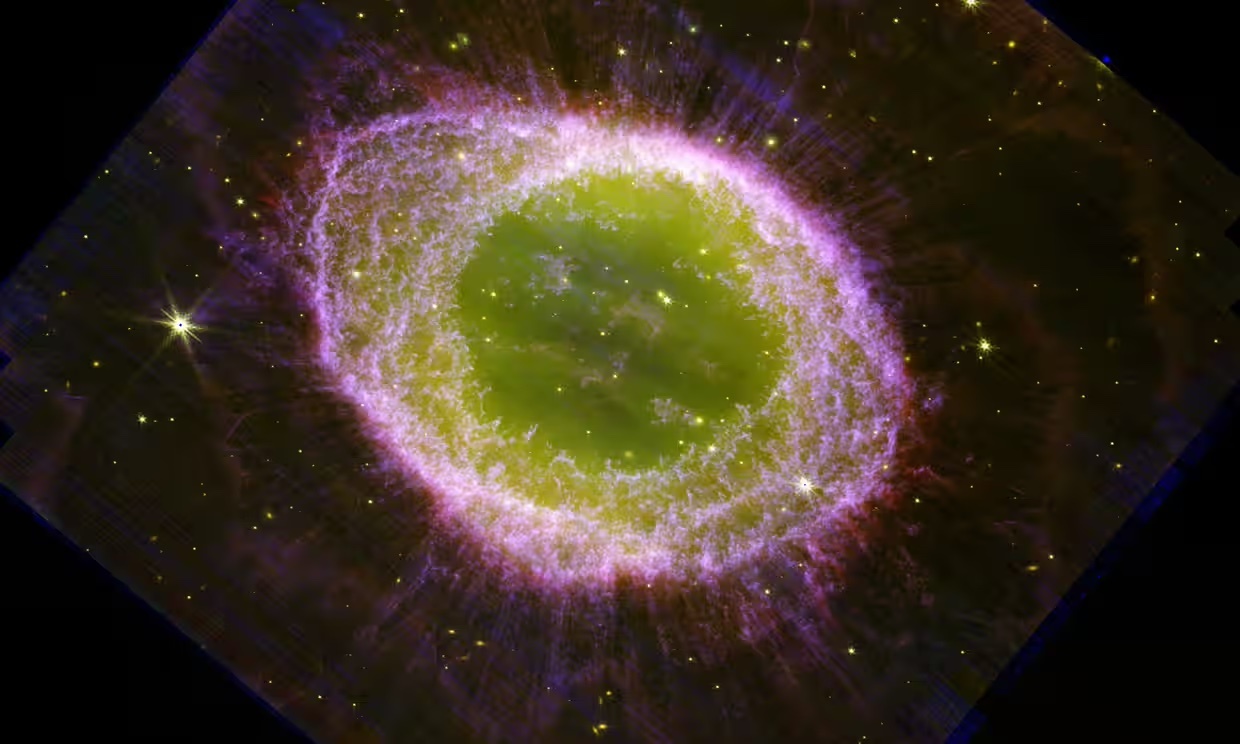
An image of the Ring Nebula captured by the James Webb Space Telescope. Photograph: The University of Manchester /PA
Stunning images of the final stages of a distant star’s life have been captured by the James Webb space telescope (JWST) in unprecedented and exquisite detail.
Released by an international team of astronomers, the snapshots reveal the doughnut-shaped structure of glowing gas called the Ring Nebula, a well-known object in the sky, which lies about 2,600 light years from Earth.
The nebula formed when a dying star blasted much of its material into space, producing vivid coloured rings, expanding bubbles and intricate, wispy clouds. A similar fate awaits the sun when it expires billions of years from now.
The high-resolution images from the telescope’s near infrared camera (Nircam), show not only the structure of the nebula’s expanding shell, but the inner region around its central white dwarf, a very dense star that is roughly the size of a planet.
Although they have nothing to do with planets, such objects are known as planetary nebulae. The term is a hangover from the early days of astronomy when scientists armed with small telescopes thought they resembled planets.
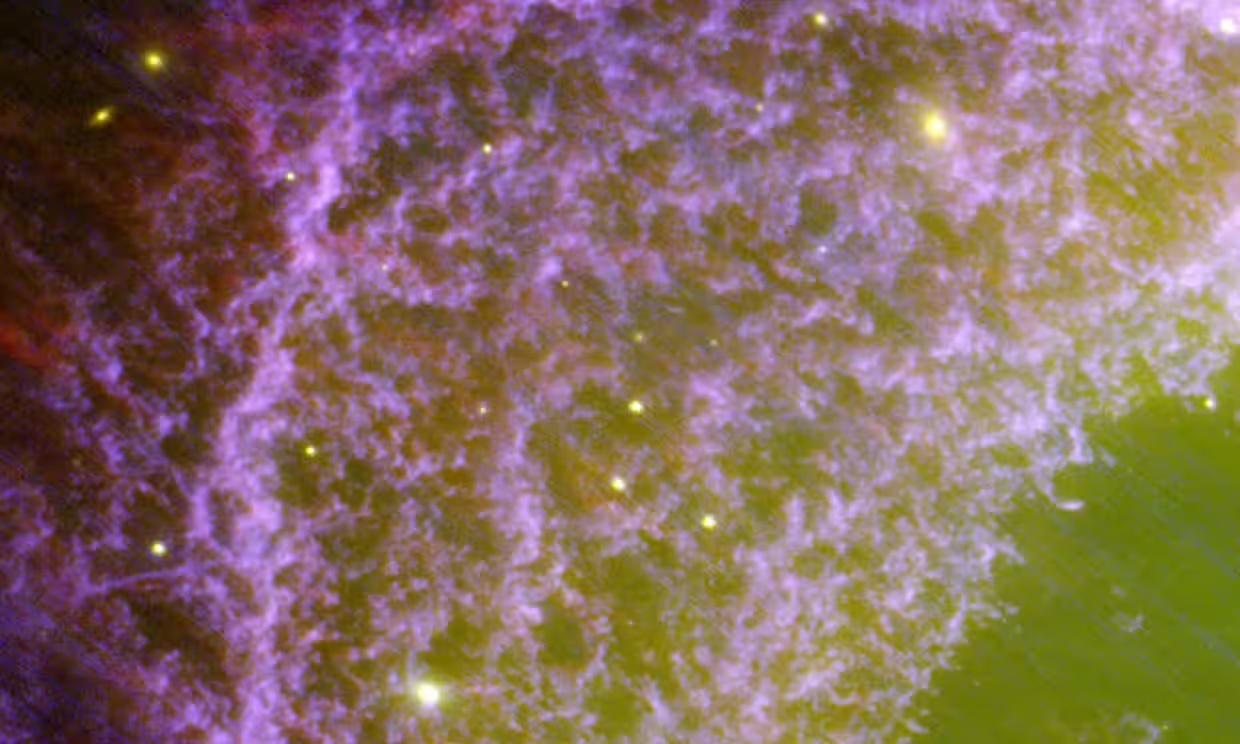
The nebula formed when a dying star blasted much of its material into space, producing vivid coloured rings, expanding bubbles and intricate, wispy clouds. Photograph: The James Webb Space Telescope (JWST)
“Stars like the sun are expected to end their lives as white dwarfs by ejecting their outer envelopes, which then form beautiful planetary nebulae that are illuminated by the radiation from their very hot pre-white dwarf central stars,” said Prof Michael Barlow, emeritus professor of physics and astronomy at UCL, who led the team.
The colourful bands in the nebula are created by chemical elements that emit light at different wavelengths. By analysing the images, astronomers hope to learn more about the complex processes that generate nebula structures and the life cycles of stars and the elements they shed into the cosmos.
“We don’t yet fully understand all the processes that take place during this caterpillar-to-butterfly-like phase,” Barlow said. “The Ring Nebula in Lyra is one of the closest and brightest of these planetary nebulae and is therefore an ideal target for JWST to study the small-scale and large-scale processes that work to form the dusty molecular structures that we see in these images.”
Quelle: The Guardian
----
Update: 19.08.2023
.
James Webb Space Telescope confirms 'Maisie's galaxy' is one of the earliest ever seen
The longer cosmic light has been traveling, the more extreme that redshift is. In the case of early galaxies like Maisie's galaxy, light has been traveling for around 10 billion years before hitting the JWST's mirrors. As a result, light that may have left Maisie's galaxy as part of the electromagnetic spectrum's visible region has been shifted down to the infrared section before reaching the spaceborne observatory.
But this is exactly why the JWST is such a remarkable tool for hunting for objects in the early universe.
Launched on Christmas Day in 2021, the powerful space telescope is adept at seeing long-wavelength infrared light. In fact, Finkelstein is clear that discovering Maisie's galaxy wouldn't have been possible prior to the JWST's tenure.
"We really could not see it before the JWST," he explained. "The Hubble Space Telescope was neither big enough nor, most importantly, did it cover 'red enough' wavelengths to see such a distant, highly redshifted galaxy."
Initial estimations of the redshift, and thus age, of Maisie's galaxy were based on photometry, which works by analyzing brightness in images while using a small number of wide-frequency filters. These calculations suggested the galaxy had a redshift of 11.8. But Finkelstein and the CEERS team wanted a more accurate age estimation.
To do this, they made follow-up observations with the JWST's Near-Infrared Spectrograph (NIRSpec). This allowed Finkelstein and colleagues to look at spectral lines created in light data, dictated by the absorptions and emissions of chemical elements at specific wavelengths. From there, they could pinpoint the actual redshift of Maisie's galaxy. It appeared to be 11.4.
This means Maisie's galaxy is technically seen more recently in the universe than initially estimated, by a factor of tens of millions of years. Nonetheless, it is still considered immensely old. The JWST captured the galaxy as it was just 390 million years after the Big Bang.
What was the universe like when Maisie's galaxy is seen?
Finkelstein explained that Maisie's galaxy would be distinguishable from galaxies in the universe today, including the Milky Way, as it is much smaller. This size is because of the dense state the universe was in during that epoch of cosmic history.
"The universe was quite active when Maisie's galaxy was seen because it was a lot smaller than it was today. So everything was squished in a much smaller volume," Finkelstein said. "Also, galaxies were closer together then, and merging much more frequently. Because the universe was only around 400 million years old at that time, essentially, all the stars that are around are young, so there were a lot more brighter and bluer stars then than we see in galaxies today."
Maisie's galaxy is also distinct from most "modern" galaxies in that, at the point we're observing it, it appears to be rapidly birthing young, blue stars. It was captured during a period in a galaxy's existence that astronomers call "starburst."
Because its young stars are bright and blue, this means (somewhat ironically) that this highly redshifted galaxy is actually much "bluer" than astronomers expected.
"There are small galaxies around today, but Maisie's galaxy is performing star formation at a much greater rate. And it's much more compact," Finkelstein said. "It's really like a blue, compact ball of stars."
This blueness also tells the team Maisie's galaxy is low in heavy elements and has a primordial composition of mostly hydrogen and helium. Maisie's galaxy is also much brighter than astronomers expected for an early galaxy, a feature that's also being found with other early galaxies observed with the JWST.
"Maisie's Galaxy gave us the first hint that early galaxies are a little bit brighter than we had expected, which makes them easier to find," Finkelstein said. "Our idea about how stars form in the universe early epoch may need a bit of revision. It's possible that galaxies were forming stars more efficiently then than we thought. Maybe they're just cranking out stars at a higher rate, with that making galaxies brighter and easier to see."
Finkelstein will now continue to examine Maise's galaxy with the JWST's Mid-Infrared Instrument (MIRI), delving deeper into the realm's light spectrum in an attempt to discover how rich it is with heavy elements, and understand whether it hosts any interstellar dust grains.
"Maisie's galaxy certainly gives us a good example case of what a galaxy in the early universe is, and because it's quite bright, we can study it pretty easily, and we can measure lots of things about it like its stellar mass, its shape and the amount of heavy elements within it," Finkelstein concluded. "In the end, it is one of many galaxies that we can use to learn about the early universe."
A paper on this study was published on Aug. 14 in the journal Nature.
Quelle: SC



